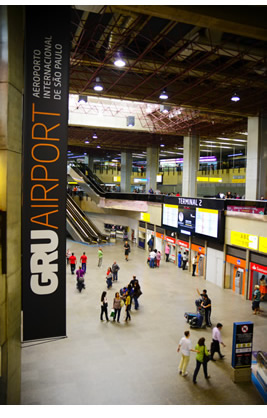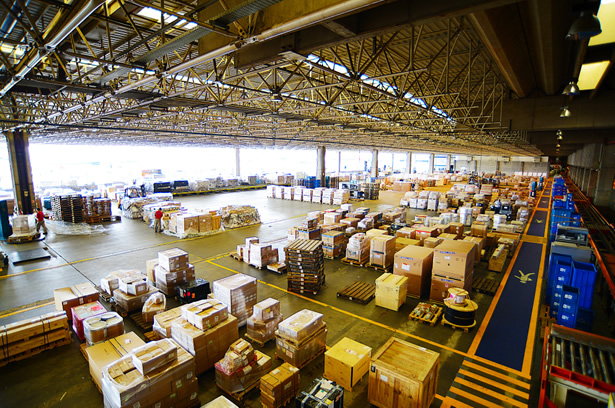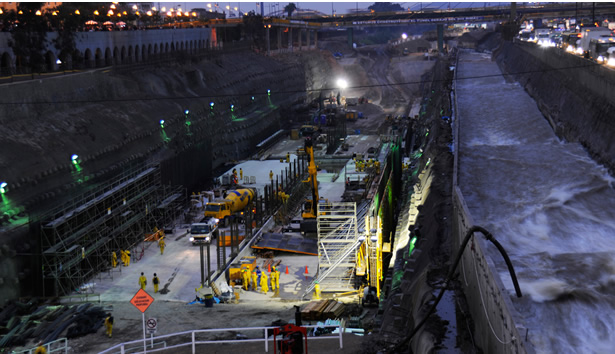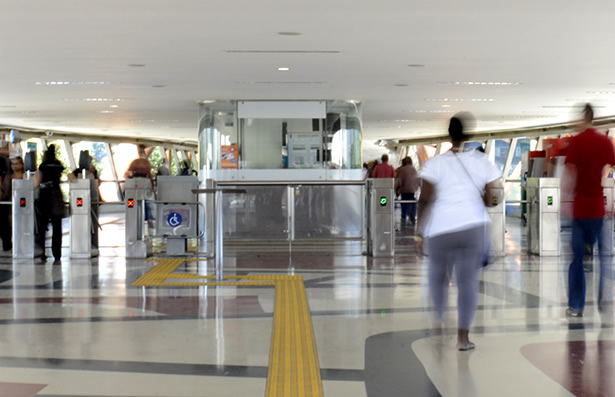2012 Achievements
- GRU AIRPORT - SÃO PAULO INTERNATIONAL AIRPORT
- VIA PARQUE RÍMAC (Lima, Peru)
- VIA EXPRESSA TRANSOLÍMPICA
- PEX
- RIO DE JANEIRO SUBWAY LINE 4
GRU AIRPORT - SÃO PAULO INTERNATIONAL AIRPORT
[GRI 2.9]

In February 2012, Invepar won the bid to operate São Paulo International Airport, located in Guarulhos, the largest airport in Latin America with 274,000 arrivals and departures and 32.8 million passengers transported in 2012.
This marked the group’s entry into a new operational segment, opening the way for new opportunities in the segment, which should be the subject of further bids in the coming years. The concession will be managed by a consortium comprising Invepar and ACSA (Airport Company South Africa), which retains 51% of the SPE (special purpose enterprise), the other 49% being held by Infraero. Of this 51%, 90% belongs to Invepar and 10% to ACSA.
ACSA has extensive experience in this role, being responsible for the operations in nine airports in South Africa, including three major international facilities: OR Tambo (Johannesburg), Cape Town and King Shaka (Durban). Since 2006, it has also been managing the airport in Mumbai, India. The company’s airports are internationally recognized for their operational efficiency and excellent user service.
Once the association between ACSA and Invepar was formalized, Concessionária Aeroporto Internacional de Guarulhos took control of operations on November 15, 2012, with definitive control scheduled for February 15, 2013*. The Company plans to invest R$6 billion in the airport by 2032, around R$3 billion of which before the 2014 World Cup. The funds will be allocated to a number of important improvements, including the construction of a new passenger terminal and a parking lot. With this in mind, in December 2012, the Company contracted its first bridge loan from the Brazilian Development Bank (BNDES) totaling R$1.2 billion, R$450 million of which has already been disbursed.
*Control was effectively transferred on that date
The main investments include construction of the new Terminal 3, which will be capable of handling 12 million passengers per year, on which work has already begun, with conclusion scheduled for 2014; a parking deck, which will add around 2,600 new parking spaces, scheduled for completion in May 2013; 22 new boarding points; a new aircraft yard with 36 aprons; widening and expansion of the runways; construction of two top-class hotels, one with 50 rooms, located in the restricted area, for passengers with international connecting flights, and the other with 350 rooms in the external area of Terminal 3; a retrofit for Terminals 1 and 2, with expansion of the baggage off-loading, passport control and X-ray areas, as well as the commercial and service areas; a convention center; and a shopping mall.
When all of the investments are concluded by the end of the concession, , capacity will have climbed from 30 to 60 million passengers, the airport will be able to hold 130 aircraft, versus the current 61, and parking spaces will have increased from 4,100 to 20,000.
| São Paulo International Airport in Numbers | ||||
| Passenger capacity | Aircraft aprons | Parking spaces | Investments | |
| Prior to concession | 30 | 61 | 4,100 | - |
| By 2014 | 42 | 97 | 10,000 | R$3 billion* |
| By the end of the concession | 60 | 130 | 20,000 | R$6 billion** |
* R$3 billion in nominal terms, equivalent to R$2.9 billion in present value.
** R$6 billion in nominal terms, equivalent to R$4.5 billion in present value.
As a means of increasing revenue from the commercial area, a project is under way to offer visitors a larger and more appropriate mix of stores, bars, restaurants, bookstores and services in general. In this context, in November 2012 the Concessionaire renewed the contracts with Dufry in the current terminals related to the duty-free retail area (items subject to tax reductions or exemption). In accordance with the new agreement, this company will continue to operate the duty-free facilities until 2016 and will expand its sales area by up to 2,100 m². Dufry currently operates a total of eight duty-free stores in the airport, with a joint sales area of around 4,500 m². The expansion of the commercial area will take place in the arrival and departure areas of Terminal 2, allowing Dufry to further increase its mix of products and offer international users best-selling brands. The new stores should be inaugurated by the end of 2013.

With the beginning of operations, the Concessionaire decided to adopt a new brand for the airport, which is now called GRU Airport – São Paulo International Airport, in line with the international standard used by the world’s main airports.
In order to manage the company responsible for the airport, an internal recruitment process was instituted to engage people who are already steeped in the Invepar culture and possess the necessary skills to assume strategic positions. Once the recruitment process is finalized, the airport’s controlling company will employ a direct workforce of around 1,800, since certain previously outsourced positions will be insourced.
VIA PARQUE RÍMAC
[GRI 2.9]
March 2012 saw the conclusion of Invepar’s merger of V.P.R. Brasil Participações S.A., which retains 100% of Linea Amarilla S.A.C. (Lamsac), a special purpose enterprise created in 2009 to explore the concession to build, maintain and operate the Via Parque Rímac toll road, in Lima, Peru. The transaction also marked Invepar’s first foray outside of Brazil, in line with its vision of becoming “a leader and international benchmark in the transport infrastructure sector.”

Located in metropolitan Lima, the toll roadis regarded as Peru’s most important urban infrastructure project, as it not only involves improved mobility, but also the regeneration of the area surrounding the Rímac River and investments in social development. All in all, there will be 25 kilometers of toll roadconnecting the main highways serving Lima to the Port of Callao and the International Airport, comprising nine kilometers of new roads, three kilometers of bridges and overpasses, four kilometers of road expansions and two kilometers of tunnel under the river, with safety, communications and operational control systems and equipment along the entire extension, together with nine new toll plazas, five of which are already functioning. When the concession is full operational, 80% of revenue will come from these five plazas. Investments are expected to total around US$703 million. Due to its characteristics, the project is very similar to Invepar’s experience of operating Rio de Janeiro’s Linha Amarela.
Community relations

One of the major challenges of a project such as Via Parque Rímac is the expropriation of properties and the relocation of residents, only successful through the development of close relations with those involved, so that they understand the benefits of the toll road and the advantages of the housing option offered by the Company. Developing initiatives to minimize the impacts on their lives is another priority.
In order to address this issue, Via Parque Rímac is building 465 apartments, 417 of which located in the Patio Unión family complex (81 ready) and 48 in the fully concluded Acomayo building. More than 40 families have already been resettled in Acomayo and 81 have requested transfer to Patio Unión. Other 32 families are living in accommodation paid by the company (at a cost similar to their previous residence).
In addition, Via Parque Rímac construction works generate 1,071 direct and 231 indirect jobs. A series of social and environmentally responsible programs are also being implemented, including an urban agriculture project in schools to teach students how to grow chemical-free crops, which will subsequently be sold to generate income. Other such initiatives include programs dealing with hygiene and the management of waste and its related diseases. Recycling measures will be introduced in the future.
The Concessionaire is also providing computer courses for the community’s teachers, students and parents, with a particular emphasis on women, so that they can contribute to household income. In this context, Via Parque Rímac set up the Mujer Emprende (Woman Get Things Done) program in association with the municipal authority, which offers courses in cooking, confectionery, handicrafts and first aid.
VIA EXPRESSA TRANSOLÍMPICA
[GRI 2.9]
Invepar will make a direct contribution to the infrastructure improvements in Rio de Janeiro, triggered by the city’s selection to host the 2016 Olympic Games. In April 2012, a consortium led by Invepar in association with Odebrecht TransPort and CCR, won the municipal bid to implement and operate the Via Expressa TransOlímpica, which will link Avenida Brasil in Magalhães Bastos with Avenida Salvador Allende in Jacarepaguá. Regarded as the city’s biggest road project in the last 30 years, the toll road is part of the Rio 2016 Olympic Plan as it will provide a direct connection between the Barra da Tijuca and Deodoro Olympic Centers.
The concession will last for 35 years, during which the consortium will be responsible for the building works, as well as the installation of the operational and maintenance systems, including 13 kilometers of three-lane toll road (two vehicle lanes and an express bus lane), a 1.53 kilometer tunnel, and 48 bridges and overpasses. The corridor will pass through the Barra da Tijuca, Recreio dos Bandeirantes, Camorim, Curicica, Taquara, Jardim Sulacap, Magalhães Bastos, Vila Militar and Deodoro neighborhoods, directly benefiting more than 400,000 people.
Invepar retains a 33.34% interest in the special purpose enterprise, while Odebrecht TransPort and CCR hold 33.33% each. The project to seek bids from Via Expressa TransOlímpica was the result of an Expression of Interest (PMI) drawn up by Invepar, a legal instrument that allows the private sector to develop technical and financial feasibility studies for projects in the public interest. It is an innovative tool that fosters proactivity and allows for the creation of competitive advantages.
Through the PMI, the state government encouraged and created the necessary conditions for the private sector to carry out infrastructure exploration studies and modeling. In some Brazilian states, they are known as Private Enterprise Expression of Interest (MIPs).
In order to develop TransOlímpica, several alternative routes were evaluated so as to arrive at the best urban mobility solution at the lowest implementation cost, always in compliance with environmental and technical regulations.
The TransOlímpica bid and victory in the Concessionária Rota do Atlântico bid in 2011 has given Invepar a relevant track record of projects structured through PMIs.
Social and environmental responsibility
Since this is a structural toll road project, the regulatory authorities require an Environmental Impact Assessment (EIA) and an Environmental Impact Report (RIMA), containing data from the environmental locations crossed by the toll road, as well as socio-economic information.
As the works are located in a highly urbanized and densely populated area, the environmental impact was considered to be low, mostly associated with air quality and noise pollution during construction. Socially, however, the impact is slightly higher – so far, 1,200 expropriations have been scheduled to accommodate the works. Such expropriations are the responsibility of the granting authority, which has the Concessionaire’s support in the preparation of certain field stages, such as the Local Production Arrangements (APL), the General Property Registry (RGI) and the socio-economic register.
PEX
In 2012, Invepar created PEX (Passe Expresso), the company that manages the Passe Expresso system, which is responsible for exclusive automatic transit lanes, allowing users to pass through toll plazas without stopping by means of an electronic chip on their windshield, thereby speeding up traffic and eliminating the handling of money.

The Passe Expresso system also has the advantage of being a prepaid mode, which allows users to purchase credits in advance. It also offers the lowest management fees in the market.
PEX is constantly attempting to increase its accredited network, which currently permits the use of the Passe Expresso system on the Linha Amarela (RJ), Rio Niterói Bridge(RJ), Via Lagos (RJ) and Concessionária Bahia Norte (BA). Invepar plans to expand the system to CLN (BA) in 2013, and also to new toll roads and shopping malls.
RIO DE JANEIRO SUBWAY LINE 4
In November 2012, Invepar signed a stock purchase agreement, for all the shares of CRB (Concessionária Rio Barra), totaling R$50 million, which holds the right to operate the concession for Line 4 of the Rio de Janeiro State Subway System. Exercise of the option is contingent upon the successful completion of the construction works scheduled for 2016 as well as compliance with the conditions precedent set forth in the agreement. Until then, Metrobarra S.A., an Invepar subsidiary, will provide systems and rolling stock for Line 4 operations. As a result, Invepar is the sole operator of the Rio de Janeiro’s Subway System, reinforcing its determination to become one of the country’s main transport infrastructure companies by expanding its activities in the urban mobility segment, which will present major challenges for Brazil in the coming years.

With start-up scheduled for 2016, Line 4 will link the city’s south side with Barra da Tijuca, add six new stations to the existing network (Jardim Oceânico, São Conrado, Gávea, Antero de Quental, Jardim de Alah and Nossa Senhora da Paz) and 16 kilometers to the current 41, facilitating the movement of more than 300,000 passengers per day who are expected to take less than 35 minutes to commute from Barra da Tijuca to the south side.

